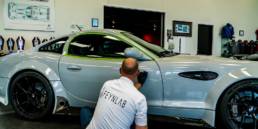How hard is a ceramic coating? What is 9H, 10H? Am I being fooled? – find out for yourself.
This is a very touchy subject as many companies have built their brand around the hardness rating.
(So and so’s) 9H Ceramic.
Let’s start with a little background on both pencil hardness and the infamous MOHS scale. The pencil hardness method was originally developed by pencil manufacturers as a quality control method in the early 1900’s, if two different pencils cause the same scratch damage to a coating then they are considered the same hardness, simple. The coatings industry adopted this in a reverse manner and starting using variations of standardized pencil hardness to measure their coating hardness.

Fast forward to the modern day and it has become an important, yet misleading, marketing tool for companies that supply vehicle protection coatings, i.e. “Ceramic” and “Glass” and other “Nano coatings”. Ever wondered why a supposedly 9H coating can be scratched with just a fingernail?
“But it’s [insert independent test company] certified!”

The test data used by these companies are valid for the tests that they have done, we are not disputing that. But if you take a more objective look you will see that they have coated a steel plate and ran it through the test, it results in a very high number, usually 9H (the maximum allowable under ASTM and BS standards). But the substrate becomes an overriding factor when testing thin films, these coatings are usually less than 5 microns and there is no-way you would get a reading of the film hardness. You are testing the hardness of the steel underneath the coating.
There have been independent studies done showing that depending on the substrate, the hardness can change by 13H values. Here’s a results table from one of these studies:

It is clear from the table above that the hardness value is significantly different when comparing PC (Polycarbonate) and (polymethyl methacrylate) as substrates. Many companies shy away from the “9H” rating, I suppose it is a long term strategy as customers and installers start being more educated, they will learn that the 9H is an utter lie. So instead they claim 7H or some lower number. And this is even more bizzare as they are actually claiming that their product is worse on a rigged scale? Wow.
Then there is the MOHS scale, where some companies and their representatives claim that their product is 9H on the MOHS scale. If this were true you should be able to scratch Glass with a dried sample, I guarantee you this is not the case. We should simply assume that they don’t understand their product well enough, nor have the ability to understand the difference between Pencil Hardness and the MOHS scale. It’s important for installers to work with suppliers that avoid embellished marketing strategies, because at the end of the day it is the installer’s reputation that is predominantly at risk.
So does a 9H coating actually exist? Yes, however a quick search didn’t yield much because all the results for “9H” returned the thousands of pop up Ceramic 9H coating companies… The coating would have to be reasonably thick, over 150 microns, and it should be relatively slippery (surface slip is an easy way to fool the pencil hardness test, as it doesn’t give the pencil the opportunity to bite). There however some industrial type coatings that are made for hard-wearing applications and need to be oven baked at a relatively high temperature. Those are examples of true 9H coatings.
And if you’re reading this thinking, “well they’re just saying that because their coatings aren’t 9H”, well we sent every single one of our coatings off to be tested following the same protocols by an independent lab, and everything came back with a glowing 9H report, as we expected…

Check some of our products
If you would like to know more what we have to offer, visit our online store or check out some of our products below.




